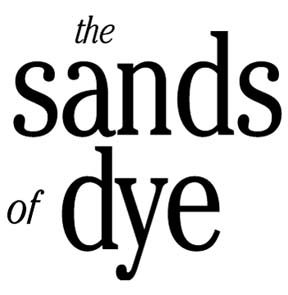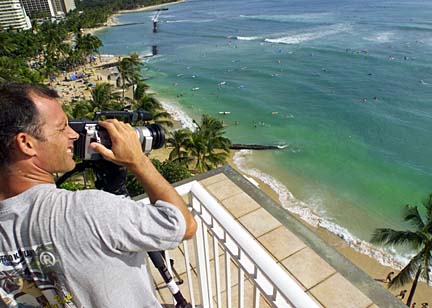

|

A green dye tests ocean currents
in Waikiki in a prelude to a
beach replenishing project
Fluorescent-green dye drifted yesterday from Kuhio Beach Ewa to an area fronting the Royal Hawaiian Hotel but stayed not far offshore and lingered there. A second release of dye hugged the shoreline and moved more slowly.
|
Over 12 hours, testing was done in half-hour increments -- in part to respond to Save Our Surf's concerns that the sand for a beach replenishment project would be pulled out and deposited along the reef, changing the way the surf breaks.
The group's spokesman, George Downing, said if that happens, the surf, rather than breaking into a peak and tapering, would break evenly like a shorebreak.
Downing said the dye test proves how water moves but not sand, which is heavier than water.
"Everyone knows the drift is going toward the Royal Hawaiian (Hotel)," he said. "For them to say that this supports their claim that the sand is going to do the same is ridiculous."
The state Department of Land and Natural Resources' $500,000 project to dredge and pump 10,000 cubic yards of sand from 2,000 feet offshore to restore three Kuhio Beach sites begins next month and will take about 30 days.
According to University of Hawaii Sea Grant coastal geologist Dolan Eversole, who performed the study for the Department of Land and Natural Resources, the experiment proves the sand would not be taken out to the reef.
Although sand does not move like water, it lifts and settles along the ocean floor following ocean currents, he said.

|
"It kind of hops down the beach," said Eversole.
Eversole said it is the first time sand will be recycled, although more than 300,000 cubic yards have been brought in from elsewhere to restore Waikiki beaches. A pilot test was done in 2000, but with equipment that did not work well, he said.
Downing said the Halekulani Hotel pumped sand during the 1920s.
Save Our Surf objects to the third site (behind the Duke Kahanamoku statue) because there is no breakwater, which the group says prevents the sand from going out to the reef.
"It's got no holding power," Downing said.
If the height of the beach is built up, Downing said, he believes the wave's high energy would bounce off the bottom and move the sand out, not follow the pattern of moving down to the Royal Hawaiian.
The group does not object to site 1, on the Ewa side of the Kapahulu Groin, or site 2, the swim area just Ewa of that.
Eversole chose yesterday to do the tests because of the anticipated south swell, to show the dye's quick movement.
The sand replenishment is a quick fix to an ongoing problem, Eversole said, noting other long-term projects are being worked on.
Many swimmers and surfers ignored the nontoxic dye, although some avoided it and some asked questions.
"I figured if it was radioactive, they would have cleared out the beach," said UH student Paul Tacci after swimming in the green-dyed water.

|